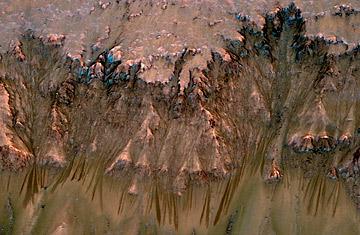
A combination image made with 3-D modeling illustrates possible evidence of liquid water active on Mars today.
American fecklessness was on painful display for much of the past week as the Washington debt-ceiling standoff revealed us to the world at our peevish worst. What was sorely needed was some reminder of what the U.S. is capable of at our enterprising best — and this afternoon NASA provided it. New images beamed back by the Mars Reconnaissance Orbiter (MRO), which has been circling the Red Planet since 2006, have produced the first compelling evidence of flowing, salty water on the Martian surface. Water may mean biology — and biology, of course, would mean Martians.
There's been little doubt in recent years that Mars was once very wet. Mineral deposits, ancient shorelines, dried up lake beds and long-empty waterways all attest to the sloshingly aquatic place the planet once was. Most of the water was lost to space due to Mars's low gravity and tenuous atmosphere. Anything that was left contracted into ice coverings in the northern and southern latitudes and perhaps retreated into the soil. If anything warm and liquid existed deeper underground — serving as a potential stew pot for organisms — there was no way of knowing.
The MRO appears to have changed that. In a paper published this week in the journal Science and announced at a press conference at NASA's Jet Propulsion Laboratory (JPL) in Pasadena, mission scientists revealed the appearance of seasonal streaks at key points on the Martian surface, looking for all the world like the tracks of water rivulets running down-slope, collecting at the base of the incline and then evaporating back into the atmosphere.
"Since the MRO arrived at Mars our overarching theme has been 'follow the water,'" says mission scientist Mike Meyer. "Now we may be catching Mars in the act. We have found repeated and predictable evidence of water flowing on the surface."
There are a lot of things about the images that make a powerful — if not yet seal-the-deal definite — case for water. For one thing, there's the seasonality. The water appears only in the Martian spring and summer when surface temperatures may range from a low of 10 below zero F to a balmy 80 above (-23 to 27°C) — and only in the planet's mid-latitudes, as opposed to the permanently frozen far north and south.
"These flows occur close to the equator," says MRO team member Phil Christensen. "They're at a latitude at which it's actually possible for water to exist." JPL images also show the events occurring over three full Martian years — a repeatability that only makes the case stronger.
